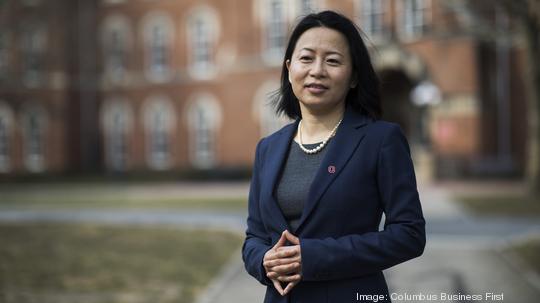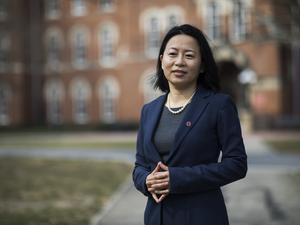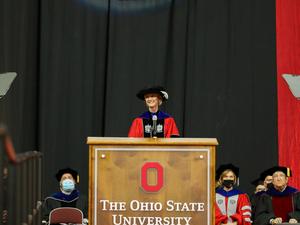
Income from commercializing technology developed at Ohio State University dropped for the second year in a row, but cumulative leading indicators hit record highs: 105 active spinoff companies and 170 licenses generating revenue.
President Kristina Johnson, entering her third year, is an inventor who has renewed emphasis on bringing discoveries to market to impact the lives of real people, and created a cabinet-level position for innovation. And OSU is putting more muscle behind the mission, approving a budget to hire more licensing officers who can secure intellectual property and pursue deals.
"I know we’re going to turn this around," said Grace Wang, executive vice president for research, innovation and knowledge enterprise. "It’s a long-term investment for the university and for the community as well."
Revenue was $3.24 million in the year ended June 30 from royalties, up-front or milestone payments, and other components of licenses and options, down from $5.7 million in 2020, the school said in response to questions from Business First. OSU licensed 114 technologies over 60 deals, and spun out 15 new startups.
The Technology Commercialization Office will grow to 13.5 full-time equivalent licensing officers this year from nine, after shrinking over the years from 15 in 2015. Other Big Ten schools with research expenditures of more than $1 billion have much larger staffs, according to data from the tech transfer trade group AUTM: 18 at Michigan, 23 at Minnesota and 24 at Wisconsin.
"I can't today take an action that’s going to produce a dollar directly tomorrow," said Kevin Taylor, who started in February 2018 as associate vice president of technology commercialization. "Our office has been chronically understaffed.
"(Under Johnson and Wang), we've gotten investments like we’ve never had before, to get the staff we need to really operate with excellence."

Record revenue of $8 million in 2018 and $8.9 million in 2019 were boosted by OSU's equity stakes in two Nationwide Children's Hospital gene therapy spinoffs that were acquired. The hospital's doctors and researchers make up the medical school's pediatric faculty, and researchers from other OSU schools were on the inventing teams.
"It’s a very exciting time," Taylor said in a joint interview with Wang. "We’re really positioned well right now to create the most potential energy we can within our portfolio."
There were 306 new invention disclosures in 2021 – the very top of the funnel when faculty or staff first bring forward research results or an invention to start exploring whether to patent it or bring to market by another method. That also was down from prior years, in part due to research disruptions in the coronavirus pandemic and comparison to a large group of copyrights for clinical guideline publications in 2017-19, Taylor said.
"We did remarkably well under difficult circumstances," he said.
The pandemic also brought discovery. Among fiscal 2021 deals, Biological E. Ltd., a pharmaceutical company in Hyderabad, India, exclusively licensed from OSU's veterinary school viral technology that can be used in developing Covid-19 vaccines. The company did not immediately respond to an email requesting an update on development since the December 2020 license.
Historically, it takes a long time to bring an invention to market, and commercialization income vacillates year-to-year with one-time hits.
“It’s almost a case of shots on goal,” AUTM CEO Stephen Susalka told me for an April deep dive on OSU and Children's tech transfer programs.
Lyrica, the drug for fibromyalgia and other autoimmune disorders, generated more than $1 billion in royalties for Northwestern University, making up nearly one-fifth of its total endowment, according to the school and AUTM data. Pfizer Inc. debuted the drug in 2005 – 18 years after a $682,000 federal grant to initiate the research at NU.
"Ohio State will have a major hit at some point in time," Taylor said. "The problem is we can't predict it."







